Warmachine: 2 Player Starter – What to Add to Your New Protectorate Army

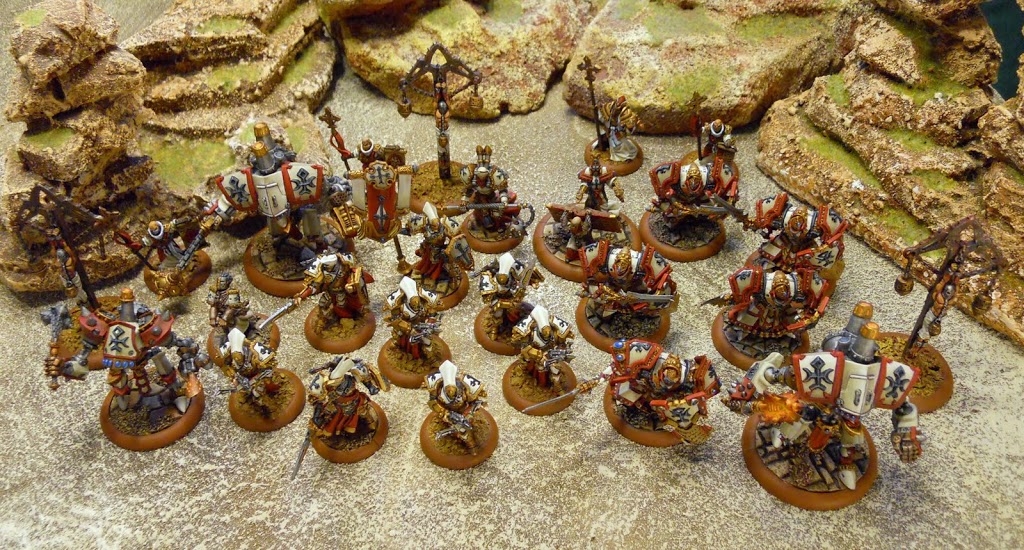
So you’ve got your initial Warmachine Starter Box models painted (or assembled at least), and you’ve played a few games with your 21 point army. Now what?
Now you’re probably going to be wondering what to add to build up to 35 and then 50 points. I’ve got some suggestions I’m hoping you’ll find helpful, but keep in mind, opinions will always differ on the best possible inclusions. Having said that, I’m not going to be recommending the most optimized and fine tuned choices for a Kreoss Pop ‘n Drop. Instead I’m going to suggest things that I think will play well with him and also be useful in the future when you start adding new ‘casters to your collections. Hopefully most of my choices will be ones everyone can agree on. Here’s the 35 pointer I’d make from the starter set contents (new additions in bold):
High Exemplar Kreoss +5 points
* Crusader 6 points
* Repenter 4 points
* Vanquisher 8 points
4 Choir of Menoth 2 points
5 Exemplar Cinerators 8 points
6 Exemplar Errants 5 points
* Exemplar Errant Officer & Standard 2 points
The Covenant of Menoth 2 points
Vassal of Menoth 2 points
3 Wracks 1 point
Now let’s take a look at why I made these choices.
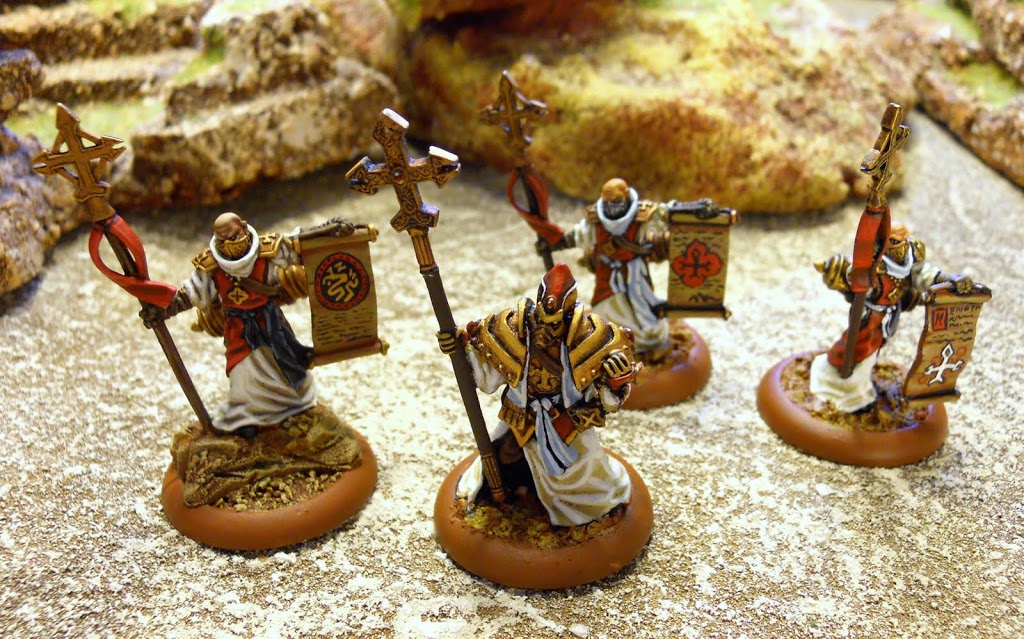
Choir of Menoth: These guys are first on the list since a minimum unit is probably the best two points any faction can spend anywhere. Whichever faction you’re fighting against, your Choir will have them groaning from the get-go. Access to any one of their abilities would probably make them worth their meager point cost, but they have three they get to pick from. First up is the Hymn of Battle, which will give your warjacks plus two to all attack and damage rolls. This is almost the equivalent of getting a free boost for every attack and damage roll you make. But since you can use Hymn of Battle and still boost, it will make your warjacks that much more accurate… or destructive, depending on what the situation warrants. Oh, and it even applies to blast damage rolls. Up next, Hymn of Passage makes it so your warjacks can’t be targeted by enemy non-magical shooting. You shouldn’t need me to tell you this can completely ruin an opponent’s entire strategy. Just as helpful is the Choir‘s final ability, Hymn of Shielding, which will keep your opponent from targeting your warjacks with spells. Don’t forget that its not just warcasters or warlocks who will be casting spells at you. Certain players base their whole strategies on using things like House Shyeel Battle Mages or Druids to move enemy heavies around so they can pick them off one by one or open up charge lanes to enemy casters. Being deprived of the ability to use their spells will devastate them. In my own experience the Protectorate is often one of my toughest match-ups. Whether I’m using Cryx or Mercenaries, debuff spells are something I’m often counting on to win games and having that taken away can cause my whole plan to unravel. One final tip: when using Choir for the first time, its important to remember that whatever abilities they use will remain on the warjack for the full duration described in the effect. That means no taking two Choirs and using one of them for Hymn of Passage after the first one used Hymn of Battle.
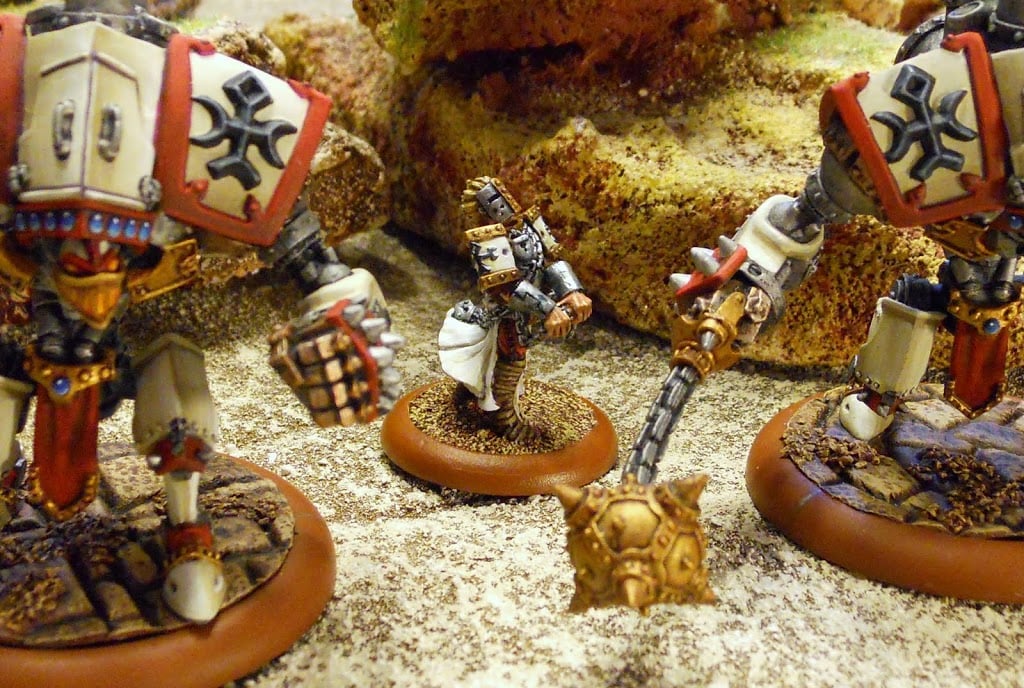
Vassal of Menoth: Another great 2 points worth of help, this guy brings the Protectorate’s warjacks to an even higher level. Ancillary Attack is the ability that makes him so popular. It lets a friendly warjack within 5 inches immediately make an attack. Its just that simple. While you can always use it to make that last melee attack you need to cripple an enemy heavy, its probably paired better with your Vanquisher. Ancillary attack ignores a weapon’s Rate of Fire, so it’s the only way to get an extra shot out of that big Flame Belcher. And since you can use Ancillary Attack before a warjack activates, you can always use it to swat an engaging model that your opponent cleverly put in your way to block a charge. You can even use it to get an attack for your warjack after it runs. But don’t get too excited. A warjack can only make one Ancillary Attack per turn. In addition, a model can only spend focus to boost during its activation. Moving on, Enliven is the Vassal‘s other key ability. It allows a warjack to advance immediately after it suffers damage outside of its activation. This one ability goes a very long way to help with one of the Protectorate’s key weaknesses: a lack of high speed. With Enliven you can put something like the slow moving Crusader up front in charge range of the enemy army knowing it can move away after taking just one hit. Your opponent’s will learn quickly that a single charge attack will rarely reduce your Crusader to below fighting strength, and when its time for your next turn they will suffer for having charged it. Just remember that you can’t advance if you’re knocked down or stationary so be wary of anything your opponent has that can put you in that state. Better yet bring along The Covenant (more on it after the break). Finally the Vassal has the Arcane Bolt spell, which it can always cast in a pinch. I find myself using it a lot late game on things like pesky solos, since the Vassal’s magic ability score of 7 makes it fairly accurate. No one expects your Vassal to go around attacking things.
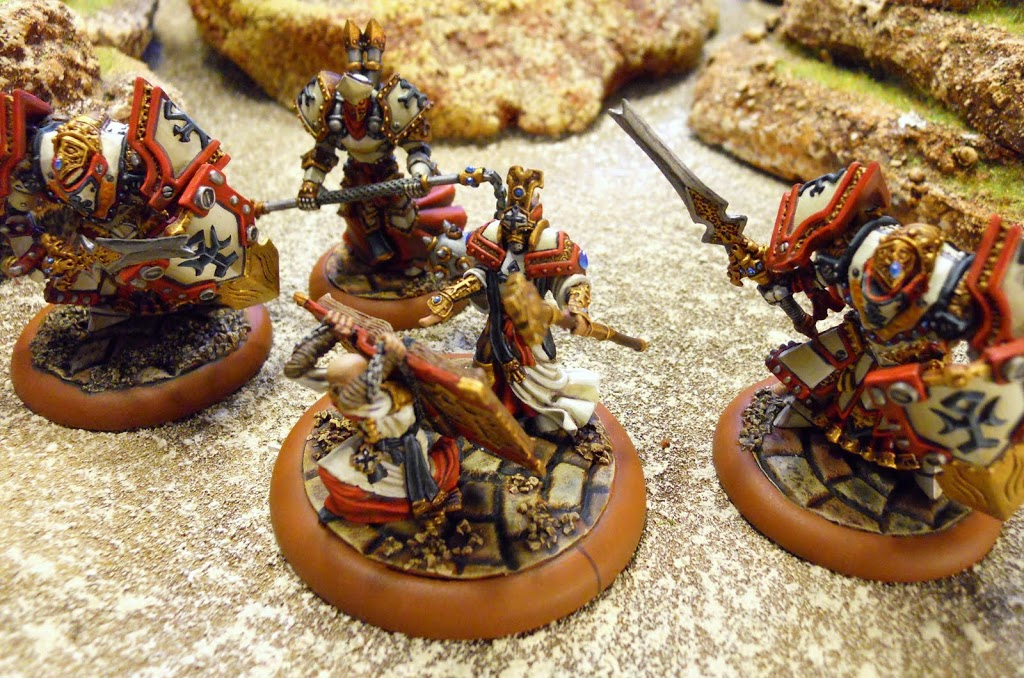
The Covenant of Menoth: AKA – The Book. Another great and nearly indispensable support piece, The Covenant offers yet another trio of useful abilities, again for a measly 2 points. Power of Faith will prevent any friendly faction models within The Covenant’s healthy 10″ command from being knocked down or made stationary. This will make you immune to the effects of no less than 3 feats, not to mention countless other spells and abilities that your opponents are probably counting on. But if you’re not worried about getting knocked down you can opt to use Flames of Wrath which will bestow the fire continuous effect onto the melee or ranged weapons of a friendly model or unit in The Book’s Command Range. This helps things in the low to medium Pow range by giving you the chance to make a second damage roll in the maintenance phase against something you couldn’t kill the first time. The Covenant‘s last active ability is Lawgiver’s Creed which will prevent any enemy model within its command range from casting spells. That’s one more anti magic ability to really stick it to your opponent. If you’re worried that using that ability will put this fragile looking solo too close to the action, read the Ancient Shroud special ability. Any successful attack against The Covenant only does a single point of damage to it. In the right circumstances, forcing your opponent to commit the resources they’ll need to to kill it may be as useful as preventing their spell casting in the first place. The one downside (if you can even call it that) to The Covenant is that despite being on a large base, the Man-Sized special rule means it can’t be used to block line of sight to small or medium based models.
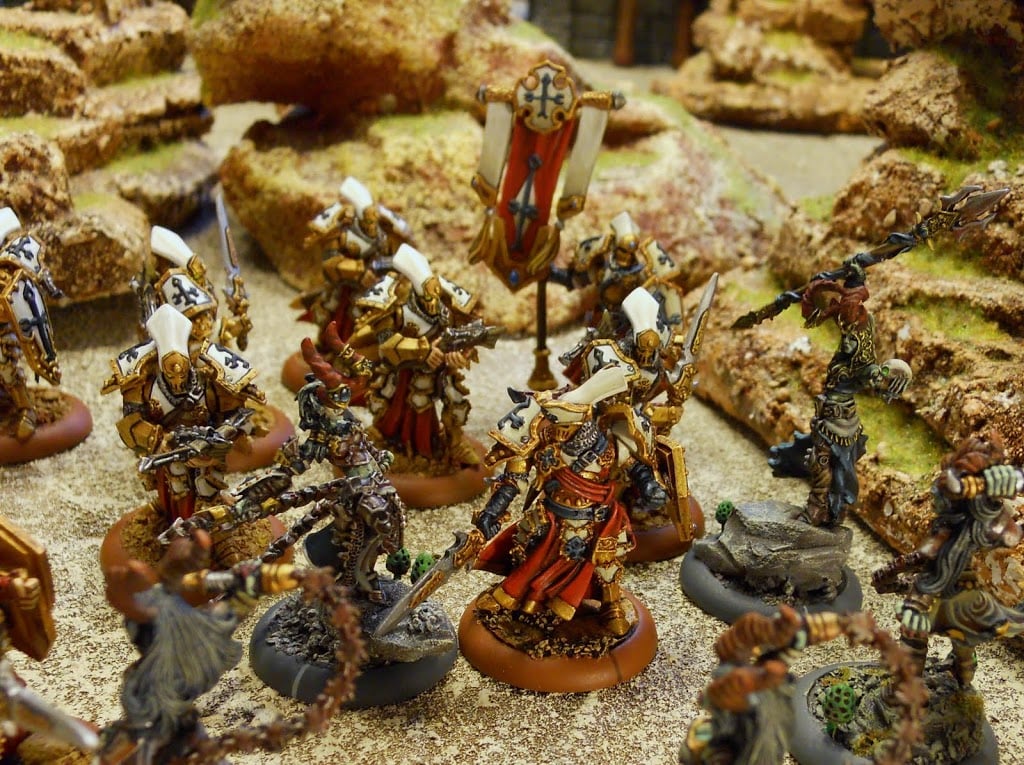
Knights Exemplar Errants: Widely considered to be the best core unit the Protectorate has to offer, the Errants have a lot of great things going for them. I think one of the big things that makes them so desirable is that they can perform well with both shooting and close combat. While only P+S 9 in melee, their swords have the Weapon Master advantage meaning they can still put some hurt on enemy warjacks and heavy infantry. And as for their shooting, having Rat 6 means they’re already above average marksmen. But it gets better. Their Heavy Crossbows also have the Blessed ability, so they ignore spell effects that add to their target’s defense or armor. The emergence of the Errants as such a popular choice has many Cygnar player bemoaning the uselessness of spells they usually count on like Blur and Arcane Shield, and rightly so. But no one’s immune. Iron Flesh, Quicken, Surefoot… these are all popular spells your Errants won’t have to worry about. But its their Self Sacrifice ability really takes them over the top. When one of your Errants would be disabled by an enemy attack, you can have another Errant within 3″ be disabled instead. The uses for this are immense. You can keep Errants on the front lines alive so the unit isn’t taken out of charge range by enemy shooting. Conversely, you can pull a different model as a casualty so that another enemy shooter no longer has an Errant in range. But if you are really careful you can sometimes cut melee casualties in half by choosing to pull your casualties from among those Errants engaging enemy models who haven’t gotten to strike yet. The downside to this unit is that the Protectorate has a lot of great abilities that trigger when a friendly model is destroyed by an enemy attack. When you use the Self Sacrifice ability, it is the ability, not the enemy model that destroys the Errant. Keep this in mind when using models that collect soul tokens, or those that benefit from similar effects. On top of everything else they also have the Advance Deployment ability letting you start them closer to enemy lines and giving you more flexibility in deployment.
Knights Exemplar Errant Officer and Standard: So if the Errants already sound like a good choice for you, how do you like the thought of making it so they can’t be targeted by enemy spells? That’s just one of the things this Unit Attachment will do for them. It also gives them Pathfinder, which can open up the battlefield for you in a huge way. Quickwork is the last new ability you’ll get, allowing you to make a ranged attack immediately if you destroy a model in melee. This greatly increases the potential number of models your Errants can kill in a turn, also allowing them to threaten models hidden deep within your opponent’s ranks. All in all this Unit Attachment is a great add-on for only 2 points; one I’d consider getting before paying for the additional 4 troopers you need to bring the unit up to full strength.
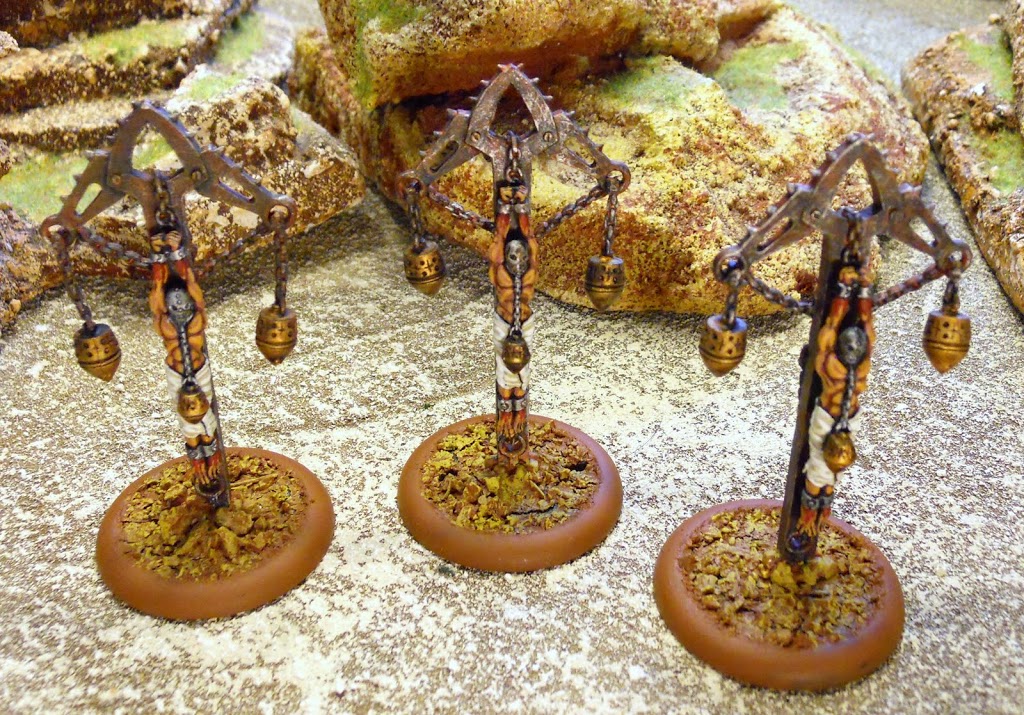
Wracks: This is the last addition to the new list. Only one point will get you three wracks, from which you may choose one each turn to give your warcaster an extra focus during their activation. Whenever you do this, there’s a fifty fifty shot the thing will explode with a five inch AoE centered on the model. Anything hit will take a pow 14. Wracks do have Advance Deployment, which will give you a little wiggle room on where you can put them, but they’re also Immobile. This means the Wracks are incredibly dangerous to your army on the first couple of turns. Its also easy for you to end up with them outside of your control area rendering them useless. I’ve found them to be worth the risk in most situations, since there’s not a warcaster in the game who doesn’t want an extra focus each turn.
So that’s our 35 right there. Lets move it up to a 50 pointer by throwing a few more things in. To start with I’m bringing the Errants up to a full unit. I’m also going to throw in another Vassal. They’re just that good. Here are my other choices:
Reckoner 8 points
Rhupert Carvolo 2 points
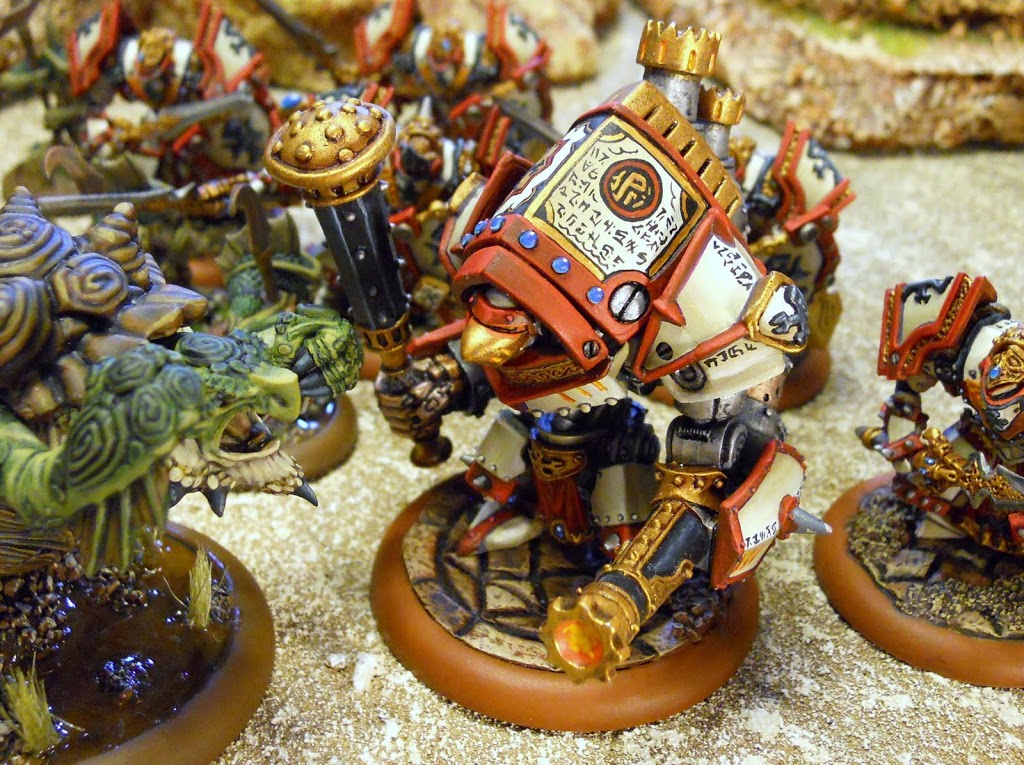
The Reckoner: There are several reasons why the Reckoner is the Protectorate warjack of choice. It’s weapon, the Consecrator, has the reach advantage. This combined with it’s natural Spd of 5 mean its natural threat range is as high as any other warjack the Protectorate can bring. It also has the Ashen Veil ability which gives it concealment at all times helping to protect it a bit from enemy shooting. This ability also confers a -2 penalty to the attack rolls of all living enemy models within 2″ offering a bit more protection for it, and nearby friendlies. Of equal importance is the warjack’s gun which sports a healthy range 12 pow 13 shot. This by itself is not particularly overwhelming, but combine that with the ‘jacks Assault ability and the Protectorate’s access to Choir. Now you’ve got a warjack with an effective Rat 7 that can threaten enemy models up to 20″ away. And yes… you can make your Assault ranged attack even if you fail a charge. If it looks like everything will come together right, you can really catch your opponent off guard with this guy. Have Kreoss charge a friendly Errant in the back, (hey this is the Protectorate… he’s giving his life for the cause) feat, then have your Reckoner Assault and boost for damage. Now have your Vassal walk up and make it shoot again. Obviously this won’t work against every caster/warlock, but if they’ve got arm 15 or below and didn’t camp focus, the odds are heavily in your favor. And all that for only 8 points.
Last up is Rhupert Carvolo. This Mercenary Bard will offer a lot of real aid to any army with this much infantry in it. During his activation he can choose to sing one of three songs which will affect him and a friendly unit. Foremost among them may be Heroic Call which grants a unit Fearless and Tough. The already obvious advantage of Tough is compounded by the presence of The Covenant of Menoth, which will allow units that make a successful Tough roll to remain standing. Dirge of Mists gives a unit +1 defense and Terror for a round. That +1 will stack nicely with the +2 from Defender’s Ward, and a failed Terror check could effectively remove an enemy unit from the game without the need to make a single attack roll. The final song, March will grant Pathfinder. Your Errants might already have it but there can still be plenty of situations where your Cinerators can use it too. There’s a reason why Protectorate players value this Mercenary as much as any of their own troops. He’s even worth considering replacing The Covenant with in your initial 35 pt list.
So those are my choices and I stand by them. One of the more popular items some may wonder why I left out was the Redeemer. This light warjack can sling 3 rockets per turn, or 4 with the help of a Vassal. And with the Choir, they’ll be hitting at pow 14. My omission of a Redeemer is in large part due to the number of things you see out there that are immune to knockdown. Since Redeemer’s are burdened with the Inaccurate special rule they’re not likely to directly hit anything standing, and I just have terrible luck with deviations. I also don’t find them being too helpful outside of High Exemplar Kreoss lists, and I told you I only wanted to suggest things I thought would be good for repeated use. So if it looks like a lot of that has to do with preference then your dead on. A Redeemer could end up working very well for you. The easiest way to get it in would be to remove the Crusader. Or you could take out the Repenter and a Vassal. Some of you may also find the omission of an Exemplar Errant Seneschal peculiar. The Seneschal’s ability to grant Hunter to the Errant unit is handy, but you’ll only use it when your enemy has woods or clouds to hide in. I just think the Vassal is going to be better in more situations. But hey the two are the same number of points, so swap them out and give the Seneschal a try. Finally I’ve completely left out a Hierophant, a very popular Protectorate choice. Well as far as he goes, I just can’t justify putting him in this list to reduce the focus cost of Purification by 1 on those few occasions when I cast it. Alright well maybe I’ll cast Cleansing Flames from time to time too, but there are so many other great 2 point options I just can’t fit him in.
~ Well that was a long article. Rather than take it any further, I’m going to hope that you readers will put your own thoughts in the comments below. I want to know whether you Protectorate players think these are good choices or not. And for any of you heathens fighting against Menoth’s chosen… does this sound like something you’d HATE to have to go up against? Let me know.

